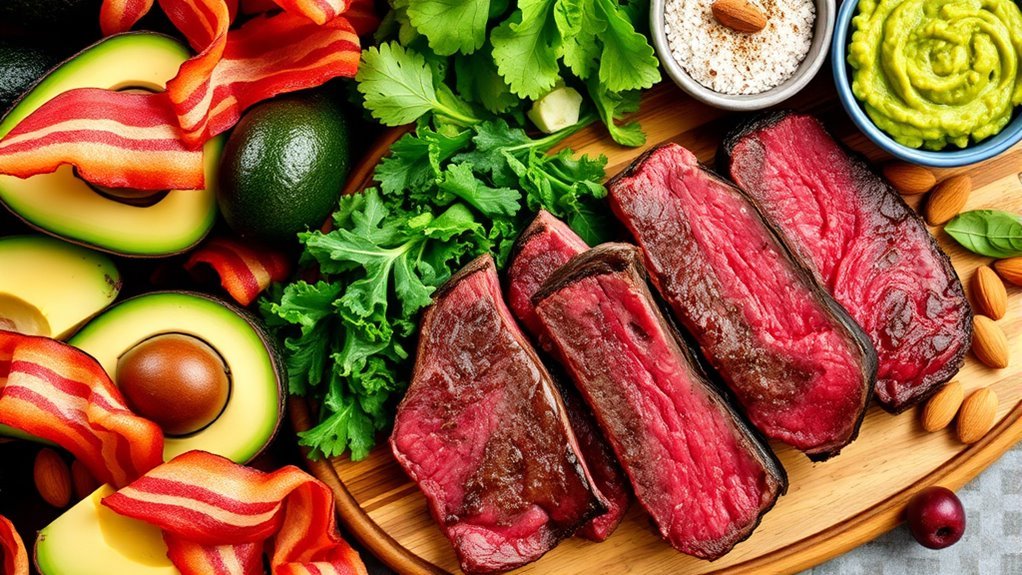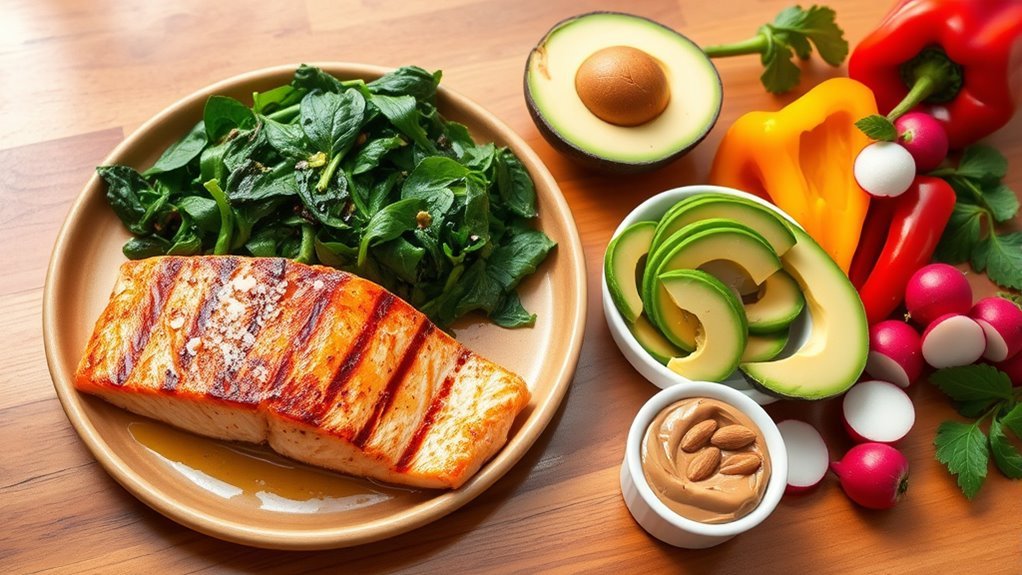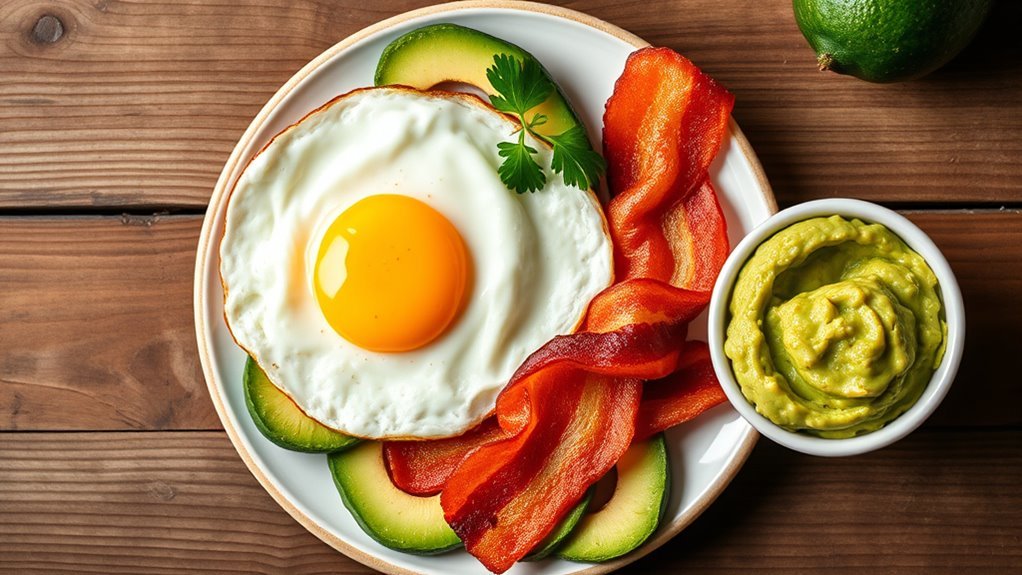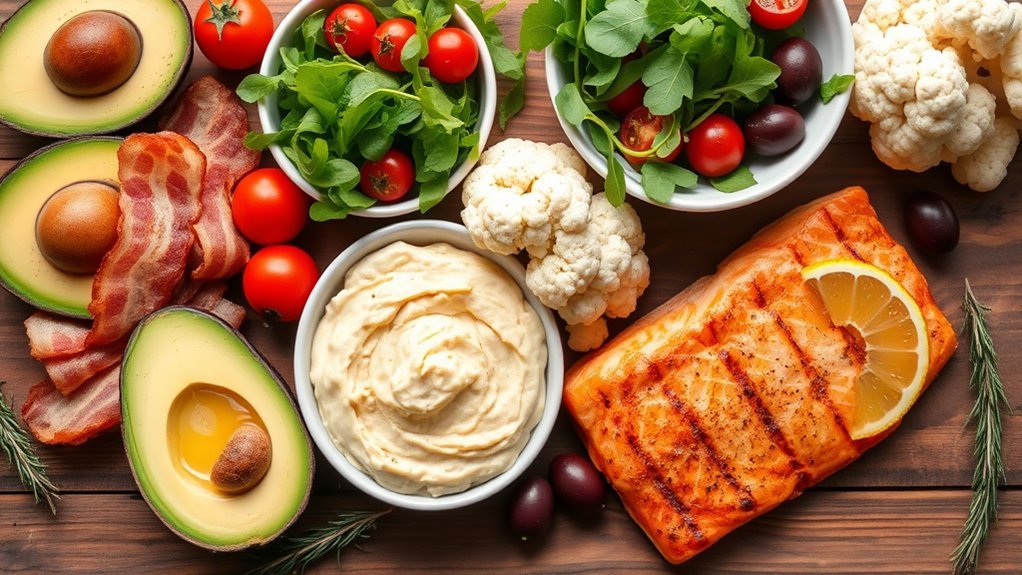On a ketogenic diet, you can enjoy a variety of foods that are low in carbs and high in healthy fats. Think leafy greens like spinach and broccoli, flavorful fats such as olive oil and avocado, and protein sources like fatty fish and eggs. Snack on nuts, cheese, or creamy yogurt for satisfaction and added nutrition. Staying informed about what works for your body is key, and there’s plenty more you can explore to guarantee success.
Understanding the Ketogenic Diet

As you explore the ketogenic diet, it’s crucial to understand that this low-carbohydrate, high-fat approach shifts your body into a state of ketosis, where it primarily burns fat for fuel instead of glucose. The keto basics revolve around reducing your carbohydrate intake, usually to about 20-50 grams per day, while increasing healthy fats, making up approximately 70-75% of your daily calories. This diet principles promote satiety and stable energy levels, which can lead to weight loss and improved mental clarity. However, it’s vital to approach the ketogenic diet mindfully, considering your nutritional needs and lifestyle. You’ll want to monitor your body’s response and adapt accordingly, ensuring you maintain a balanced and sustainable way of eating that supports your freedom and health goals.
Foods to Enjoy on Keto

On a ketogenic diet, you’ll find that there are plenty of delicious foods to enjoy while staying within your carb limits. Low-carb vegetables, healthy fat sources, and protein-rich foods make up the foundation of your meals, providing essential nutrients without compromising your goals. By focusing on these food groups, you can create satisfying dishes that align with the principles of keto.
Low-Carb Vegetables
While guiding through the keto diet, you’ll find that incorporating low-carb vegetables can greatly enhance your meals without jeopardizing your carbohydrate limits. These veggies not only provide essential nutrients but also offer significant keto vegetable benefits. They’re perfect for low carb cooking, helping you stay within your goals while enjoying flavorful dishes. Here are four excellent options to contemplate:
- Spinach
- Zucchini
- Cauliflower
- Broccoli
These vegetables are versatile and can be used in salads, stir-fries, or casseroles. They’ll add texture and color to your plate while keeping your carb count low. Embracing low-carb vegetables can truly liberate your cooking, allowing you to explore a variety of delicious, healthy meals on your keto journey.
Healthy Fats Sources
Incorporating healthy fats into your keto diet is essential for achieving and maintaining ketosis, since fats serve as the primary energy source when carbohydrates are limited. You’ll want to embrace a variety of healthy fats, such as avocado oil and olive oil for cooking or drizzling on salads. Nut butters, like almond and macadamia, offer delicious options for snacking. Don’t forget fatty fish like salmon for omega-3s, and embrace grass-fed butter and ghee for cooking. Include chia seeds and pumpkin seeds for added nutrients. You can also explore flaxseed oil, hemp oil, and sesame oil as versatile additions. These sources of healthy fats not only support your keto journey but also contribute to overall well-being. Enjoy the freedom to indulge!
Protein-Rich Foods
To thrive on a keto diet, it is crucial to include a variety of protein-rich foods, as they help preserve muscle mass and keep you feeling satisfied. Incorporating the right keto protein sources can make all the difference in your journey. Here are some great options to take into account:
- Eggs – Packed with nutrients and versatile for any meal.
- Chicken – Lean and easy to prepare in countless ways.
- Fish – Rich in omega-3s, providing both protein and healthy fats.
- Greek Yogurt – A delicious, high-protein snack that can be sweetened or enjoyed savory.
Including these high protein snacks not only keeps hunger at bay but also supports your overall health while maintaining ketosis. Enjoy your freedom to explore these tasty options!
Healthy Fats for Your Keto Plate

When following a keto diet, incorporating healthy fats is essential for maintaining energy and supporting overall health. You’ll find a variety of options, from avocados and nuts to olive oil and coconut oil, each offering unique benefits. Knowing how to cook with these fats can elevate your meals while keeping your carb intake in check.
Types of Healthy Fats
While many diets shy away from fats, the keto diet embraces them as a cornerstone of its nutritional framework. By focusing on nutrient density, you can choose healthy fat sources that fuel your body while keeping you satisfied. Here are four excellent options:
- Avocado Oil: Rich in monounsaturated fats, it promotes heart health.
- Coconut Oil: Contains medium-chain triglycerides (MCTs) for quick energy.
- Olive Oil: Packed with antioxidants, it supports overall wellness.
- Grass-Fed Butter: Full of vitamins and beneficial fatty acids.
Incorporating these healthy fats into your meals not only enhances flavor but also aids in meeting your keto goals while allowing you the freedom to enjoy your food.
Cooking With Healthy Fats
Cooking with healthy fats can elevate your keto meals, adding both flavor and nutritional value. Incorporating options like olive oil and coconut milk not only enriches your dishes but also provides essential fatty acids. The avocado benefits are numerous; it’s a great base for creamy salad dressings or fat bombs. Nut butters can serve as delicious flavor enhancers and are perfect for baking with fats. If you’re looking for ghee alternatives, consider using avocado oil or coconut oil for high-heat cooking methods. These fats can transform your meals into satisfying delights while keeping you aligned with your keto goals. Embrace these ingredients, and enjoy the freedom to create diverse, flavorful dishes on your keto journey!
Proteins That Fit the Keto Lifestyle
Many people seeking to embrace the keto lifestyle often wonder which protein sources best align with their dietary goals. Here are some excellent options to reflect upon:
- Lean meats: Opt for cuts like chicken breast or pork loin for a healthy protein boost.
- Seafood options: Fatty fish like salmon or sardines provide omega-3s along with protein.
- Egg benefits: Eggs are versatile and nutrient-dense, making them a staple in keto diets.
- Plant proteins: Contemplate meat alternatives like tofu or tempeh for added variety.
Incorporating these protein sources can help you stay satisfied while adhering to your keto lifestyle. Don’t forget about protein powders, which can supplement your intake, especially for those on-the-go!
Low-Carb Vegetables to Include
Incorporating proteins is just one part of the keto diet; choosing the right vegetables is equally important for maintaining low carbohydrate intake. Low-carb vegetables like spinach, zucchini, and cauliflower are fantastic options that provide essential nutrients without spiking your carb count. These veggies not only add variety to your meals but also come with numerous vegetable benefits, including high fiber and vitamins. You can easily incorporate them into keto friendly recipes, such as cauliflower rice or zucchini noodles, making it simple to enjoy flavorful dishes that align with your goals. Remember, embracing these low-carb veggies allows you to sustain a balanced diet while enjoying the freedom to explore diverse meals and flavors on your keto journey.
Dairy Options for a Keto-Friendly Diet
When following a keto-friendly diet, choosing the right dairy options can enhance your meals while keeping carbs low. Low-carb cheeses, like mozzarella and cheddar, provide essential fats and protein without derailing your carb count. Additionally, creamy dairy delights such as heavy cream and Greek yogurt can add richness and flavor to your dishes, making them satisfying and enjoyable.
Low-Carb Cheese Choices
Cheese is a delightful staple for those following a keto diet, offering a range of flavors and textures without the high carb count found in many other foods. When choosing cheese varieties, opt for low-carb options that fit seamlessly into your meal plan. Here are four excellent choices:
- Cheddar
- Mozzarella
- Cream cheese
- Gouda
These cheeses not only provide essential nutrients but also pair well with a variety of keto-friendly foods. You can enjoy cheddar with avocado, mozzarella on zucchini noodles, cream cheese in savory dips, or Gouda alongside nuts. Incorporating these low-carb cheese choices into your diet allows for satisfying meals while keeping your carb count in check, giving you the freedom to enjoy delicious flavors.
Creamy Dairy Delights
While many people think of cheese as the primary dairy option on a keto diet, there are plenty of creamy delights that can enhance your meals without kicking you out of ketosis. Cream cheese is a versatile choice for both savory and sweet dishes, adding richness without many carbs. If you’re looking for butter alternatives, ghee or coconut oil can provide that creamy texture you crave. For yogurt options, choose full-fat, unsweetened varieties—these can be topped with berries for a low-carb treat. Don’t forget about keto ice cream, which satisfies your sweet tooth while keeping carbs low. Finally, whipped toppings made from heavy cream can be the perfect finishing touch for your desserts, allowing you to enjoy creamy flavors guilt-free.
Snacks and Treats for Keto Success
Finding satisfying snacks and treats on a keto diet can be challenging, yet it’s essential for maintaining your energy levels and curbing cravings. Fortunately, there are plenty of delicious keto snack ideas that won’t derail your progress. Here are four tasty low carb treats to evaluate:
Finding satisfying snacks on a keto diet is crucial for energy and cravings, but there are plenty of delicious options to explore.
- Nuts and Seeds – Almonds, walnuts, and pumpkin seeds are excellent for snacking.
- Cheese Crisps – Baked cheese crisps provide that crispy crunch without the carbs.
- Veggies with Dips – Cucumber or celery sticks paired with guacamole or ranch dressing.
- Dark Chocolate – Choose varieties with at least 70% cocoa for a sweet treat that’s still keto-friendly.
With these options, you’ll feel free to enjoy satisfying snacks while staying on track with your keto journey.
Beverages to Keep You Hydrated
Staying hydrated is just as important on a keto diet as choosing the right snacks. When it comes to keto-friendly drinks, water should be your go-to option. It’s calorie-free, carb-free, and essential for overall health. Herbal teas and black coffee are also excellent choices, providing flavor without added sugar or carbs. If you crave something fizzy, opt for sparkling water, but check labels to avoid hidden sugars. As for hydration tips, consider adding electrolytes, especially sodium, potassium, and magnesium, to your drinks. This can help counteract any imbalances from reduced carb intake. You’ve got the freedom to explore different beverages, just stay mindful of their ingredients to keep your keto journey on track.
Meal Planning Tips for Keto
When you begin a keto diet, effective meal planning becomes essential to guarantee you meet your nutritional goals without succumbing to carb-laden temptations. Here are some meal prep tips to help you stay on track:
- Create a grocery checklist: Focus on low-carb veggies, proteins, and healthy fats to streamline your shopping.
- Batch cook meals: Prepare several servings at once to reduce daily cooking time and avoid last-minute unhealthy choices.
- Use airtight containers: Store meals in portioned containers for easy access throughout the week.
- Plan for snacks: Include keto-friendly snacks like nuts and cheese to curb hunger between meals.
Common Mistakes to Avoid on Keto
Although many people commence a keto diet with the intention of losing weight and improving their health, several common mistakes can hinder progress. One common keto pitfall is neglecting proper keto meal prep, leading to impulsive eating choices. It’s essential to plan and prepare meals in advance to avoid high-carb temptations. Another mistake is not tracking your macros; without monitoring your intake, you might unknowingly consume too many carbs. Additionally, some may over-rely on processed keto products, which can contain hidden sugars. Finally, don’t forget to stay hydrated and maintain electrolyte balance, as dehydration can lead to fatigue. By being aware of these common pitfalls, you can navigate your keto journey more effectively and enjoy the freedom it offers.


